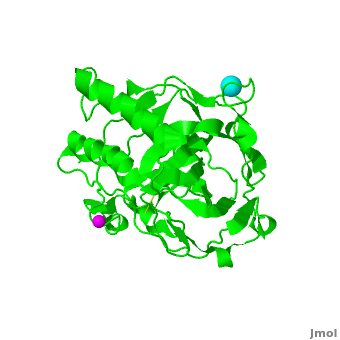Function
Carbonic anhydrase (CA) are enzymes which catalyze the interconversion of CO2 and water to bicarbonate and proton. The active site contains Zn atom.[1] CA enzymes are divided into several classes:
- α-carbonic anhydrase are found in mammals and the human enzyme has 15 isoforms.
- β-carbonic anhydrase are found in prokaryotes.
- γ-carbonic anhydrase are found in methane-producing bacteria. For full entry on γ-carbonic anhydrase see Gamma Carbonic Anhydrase.
- iota-carbonic anhydrase shows catalytic activity without metal ions[2].
For more details on carbonic anhydrase II see Carbonic Anhydrase IX With Saccharin, Molecular Playground/Carbonic Anhydrase, and Acetazolamide.
Disease
Carbonic anhydrase II deficiency syndrome is a recessive disorder that causes osteopetrosis, renal acidosis and cerebral calcification.
Structural highlights
of the of carbonic anhydrase from Dunaliella salina (dCA II) structure. The regions corresponding to conserved regions (CRs, blue), variable regions (VRs, green), and variable conserved regions (VCRs, red), are positioned on the dCA II structure. The catalytic Zn2+, insertions and deletions in VCRs including L1 (the Zn binding loop), L4 (the Na-binding loop), L5, and two extended α-helices (E and G) are marked. N and C termini are labeled. .[3]
3D Structures of Carbonic anhydrase
Carbonic anhydrase 3D structures

